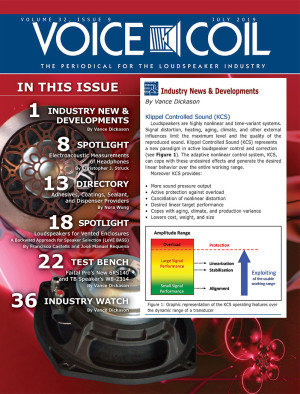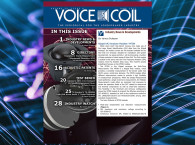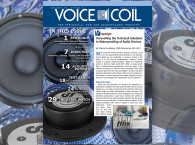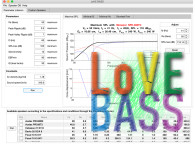 Voice Coil July includes an overview of the new Klippel Controlled Sound (KCS) technology, a new paradigm in active loudspeaker control and correction based on a lumped parameter model, which considers the dominant nonlinearities inherent in a moving coil motor structure and in the mechanical suspension system. KCS technology allows the exploitation of all hardware resources for transducer design, which makes drivers smaller, lighter and more cost effective, leading to a new generation of "green speakers" producing more acoustical output and less heat by requiring less energy.
Voice Coil July includes an overview of the new Klippel Controlled Sound (KCS) technology, a new paradigm in active loudspeaker control and correction based on a lumped parameter model, which considers the dominant nonlinearities inherent in a moving coil motor structure and in the mechanical suspension system. KCS technology allows the exploitation of all hardware resources for transducer design, which makes drivers smaller, lighter and more cost effective, leading to a new generation of "green speakers" producing more acoustical output and less heat by requiring less energy.
In a Spotlight article, Christopher J. Struck (CJS Labs) discusses "Electroacoustic Measurements of Headphones," a very detailed, and updated overview on all options available for headphone testing and calibration. The article discusses what should be included in a complete headphone test system, considerations on electrical impedance, considerations on repeatability of the results, free and diffuse field corrected responses, left-right tracking, and the use of two-tone distortion measurements. Reference reading material.
Another interesting Voice Coil Spotlight, Francisco Castells and José Manuel Requena (Universitat Politècnica de València, Valencia, Spain) detail "A Backward Approach for Speaker Selection (LoVE BASS)." The two authors explore the problem of designing vented enclosures, describing a backward concept they call LoVE BASS, which they found to save a substantial amount of engineering hours during the process of speaker box design. As opposed to taking a given driver and designing an enclosure, the authors define the system’s target performance in terms of physical volume, lower cut-off frequency, ripple and maximum achievable SPL, after which they look for candidate drivers that allow for such a design.
For this July 2019 edition, Nora Wong (Menlo Scientific, Ltd.) compiled an updated directory of Adhesives, Coatings, Sealant, and Dispenser Providers. As noted in the introduction, there are more than 1,000 vendors of adhesives, coatings, treatments, dispensers, and applicators but few are experienced or have optimized their offerings for the speaker industry. The directory highlights the leaders that the US and European speaker industry has relied on for decades, along with a few unique specialists that may come in handy for those working at the leading edge of design.
In Test Bench, Vance Dickason characterizes a pro sound midrange woofer, Faital Pro’s 6” 6RS140, and the W8-2314, a new 8” high-end home audio coaxial driver from Tang Band (TB) Speaker.
The Faital Pro 6RS140 has a power handling rating of 200 W (AES) and targets applications as a midbass or midrange in three-way stage or studio monitors, as well as midrange arrays in large PA systems. The frame is a proprietary four-spoke cast-aluminum frame, and like many small diameter drivers, it does not have a venting below the spider mounting area. Cooling for this driver is provided by a 20 mm diameter pole vent with a 22 mm flared exit. It features a curvilinear paper cone with a pressed and treated polycotton half-roll surround, and a 4” diameter flat black cloth spider with constant height waves. The motor design on the Faital Pro 6RS140 utilizes a FEA-designed neodymium ring magnet fitted with an aluminum shorting ring, using a 44 mm (1.73”) diameter voice coil wound with round aluminum wire on a nonconducting glass fiber former. The neodymium ring magnet is sandwiched between a milled and polished front plate and a cast shaped T-yoke with a 15 mm bump-out.
 The second driver, recently released by Tang Band (TB) Speaker is a coaxial design that Dickason describes "as unique a design as I have encountered in quite some time." The TB Speaker W8-2314 is built on an eight-spoke two-part ABS injection-molded frame that incorporates a separate injection-molded trim ring. Cooling for this driver is provided primarily via the completely open area below the spider (damper) mounting shelf. Incorporated into the frame is the underhung-type woofer motor that consists of a circular array of six neodymium slugs — an arrangement that makes room for the concentrically mounted 25 mm tweeter and tweeter rear cavity. The multi-neodymium magnet underhung motor drives a 44.43 mm diameter voice coil wound with round copper wire on a conducting aluminum former glued to a moderately curvilinear bamboo fiber paper cone. The tweeter dome is a 25 mm aluminum/magnesium alloy inverted type suspended with a black NBR/CBR surround that has similar oval reliefs around its perimeter.
The second driver, recently released by Tang Band (TB) Speaker is a coaxial design that Dickason describes "as unique a design as I have encountered in quite some time." The TB Speaker W8-2314 is built on an eight-spoke two-part ABS injection-molded frame that incorporates a separate injection-molded trim ring. Cooling for this driver is provided primarily via the completely open area below the spider (damper) mounting shelf. Incorporated into the frame is the underhung-type woofer motor that consists of a circular array of six neodymium slugs — an arrangement that makes room for the concentrically mounted 25 mm tweeter and tweeter rear cavity. The multi-neodymium magnet underhung motor drives a 44.43 mm diameter voice coil wound with round copper wire on a conducting aluminum former glued to a moderately curvilinear bamboo fiber paper cone. The tweeter dome is a 25 mm aluminum/magnesium alloy inverted type suspended with a black NBR/CBR surround that has similar oval reliefs around its perimeter.
Voice Coil July 2019 also includes the usual compilation of important updates in its Industry Watch section, compiled by Dickason.
This edition is available for download and already in the mail for print subscribers. Subscribers can go to - www.gotomyvcoil.com - to download this issue.
Remember, Voice Coil is available in print and download for all registered subscribers, free for industry professionals. To qualify for a free subscription to Voice Coil, or renew your subscription, go to: audioxpress.com/page/Voice-Coil-Subscriber-Services.html.

- on Magazine News
- News
The Latest Resources for Transducer Measurement and Design in Voice Coil July 2019
June 26 2019, 11:50
The July 2019 edition of Voice Coil is now available and loaded with valuable articles, starting with an overview of the new Klippel Controlled Sound (KCS) technology, followed by a detailed article on headphone measurement, and a new backward concept for designing vented enclosures. The July edition also features an updated directory of Adhesives, Coatings, Sealant, and Dispenser Providers. In Test Bench, Vance Dickason characterizes a Faital Pro midrange woofer and a coaxial driver from Tang Band (TB) Speaker. Download your copy now!





